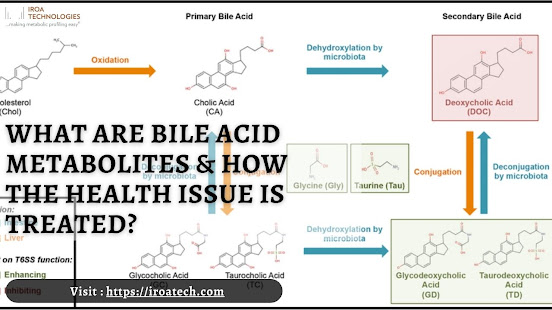Common Errors That Occur During Bile Acid Metabolism
It takes the liver at least 14 enzymatic steps to generate bile acids from cholesterol, and the process takes place in a complicated chain of events. The inability to carry out any of these processes will lead to a failure to create "normal bile acids" and the buildup of odd and intermediate bile acid metabolites due to the failure to carry out any of the reactions above.
Bile acid production is impaired, which results in reduced bile flow and impaired intraluminal solubilization of fat and fat-soluble vitamins. When the bile acid biosynthesis pathway is blocked, the produced intermediates may be harmful to the hepatocytes in certain instances. Infants, toddlers, and adults have been discovered with several documented inborn defects in bile acid metabolism that cause enzyme shortages as well as decreased bile acid production.
Symptoms of fat and fat-soluble vitamin malabsorption may be evident in patients who have had neonatal cholestasis or neurologic illness. Lower intestinal bile acid levels, which may cause major illness and mortality if left untreated, can increase liver disease. This article aims to provide a comprehensive overview of the diseases of bile acid production that are caused by single abnormalities in the metabolic pathway.
Inborn Errors of Bile Acid Metabolism
Below are a few of the errors that occur during the metabolism process of bile acids.
Deficiency of Δ4-3-oxosteroid-5β-reductase
It is also known as an autosomal recessive condition which leads to the defective synthesis of the bile acid steroid nucleus.
7α-Hydroxy-4-cholesten-3-one along with the 7α-12α-Dihydroxy-4-cholesten-3-one is converted into 3-oxo-5β analogs by the enzyme AKR1D1. The reduction of the double bond between C4 and C5 of the steroid nucleus is impaired in the presence of a deficiency of this enzyme. As a result, limited quantities of normal primary bile acids are present in the urine and plasma of afflicted individuals.
Cerebrotendinous Xanthomatosis
Deficiency in mitochondrial sterol 27-hydroxylase leads to alterations in side-chain of bile acids, which results in Cerebrotendinous xanthomatosis (CTX), an extremely uncommon autosomal recessive lipid storage condition. A decrease in oxidative capacity of the side-chain of cholesterol can increase synthesis and metabolism of cholesterol, more excretion of bile alcohol glucosides, and deviant accumulation of cholestanol and cholesterol in tissue, especially in the neurological system and cardiovascular system. Various mutations cause CTX in the sterol 27-hydroxylase gene CYP27A1, which is located on the long arm of chromosome 2.
D-Bifunctional Protein Deficiency
Abnormal peroxisomal fatty acid oxidation occurs when D-bifunctional protein is deficient. D-3-hydroxyacyl-CoA-dehydratase and D-3-hydroxyacyl-CoA-dehydrogenase are the two enzymes that make up the D-bifunctional protein. Depending on which protein subunit is compromised, there are three distinct types of D-bifunctional protein insufficiency. Individuals who suffer from type I deficiency are defective in dehydratase and dehydrogenase subunits.
The Dehydrogenase component is lacking in subjects with type 2 deficiencies, while the dehydratase subunit is lacking in patients with type III deficiencies. Type II deficiencies are more common than type III deficiencies, which are more common than type II deficiencies. Mutations in the HSD17B4 gene are responsible for the disorder. In individuals with D-bifunctional protein deficiency, both peroxisomal beta-oxidation and oxidation of bile acid precursors are aberrant. Symptoms include hypotonia, convulsions, craniofacial anomalies, vision impairment, and psychomotor retardation in certain cases.
Zellweger Syndrome
Inheritance of the ailment Zellweger syndrome is a kind of autosomal recessive disease that affects peroxisomal biosynthesis, which includes the bile acid production routes and other peroxisomal processes. The C27 bile acids dihydroxycholestanoic acid and trihydroxycholestanoic acid are beta-oxidized in peroxisomes to generate the C24 main bile acids cholic acid and chenodeoxycholic acid.
The human condition Zellweger syndrome is connected with mutations in 12 genes that have been identified so far. PEX1 mutations are the most often discovered mutations in people who have Zellweger syndrome, according to research. This group of genes encodes proteins known as peroxins, which are required for the appropriate assembly of functioning peroxisomes in the body.
Last Words
A growing number of serious hepatic illnesses include defects in bile acid metabolism. Diagnosing newborn cholestasis and chronic liver disease requires clinical suspicion. If identified early using the bile acid metabolites, these problems may be efficiently treated with bile acid replacement treatment. These tests are currently only accessible in a few specialist referral labs. We can better comprehend uncommon liver illnesses with current biochemical and molecular tools.


Comments
Post a Comment